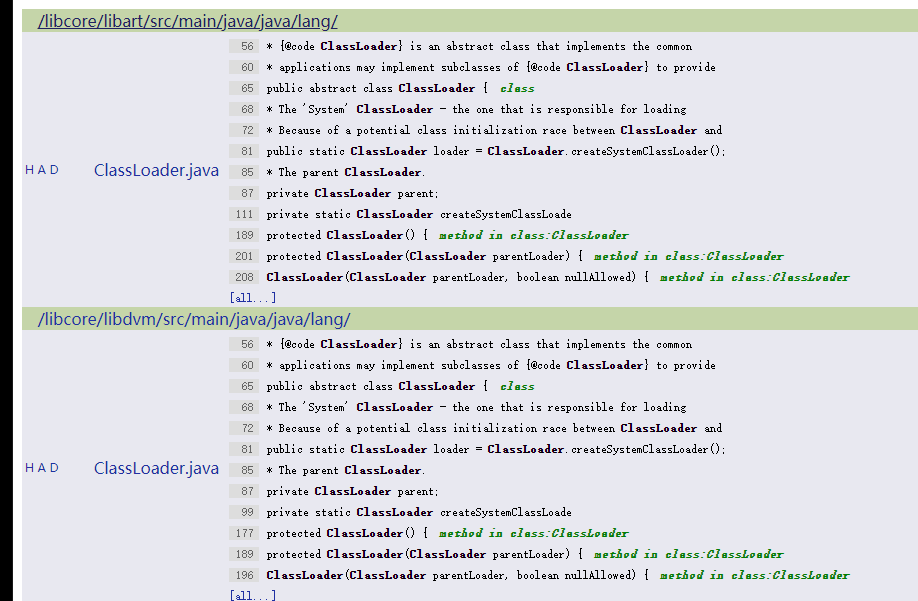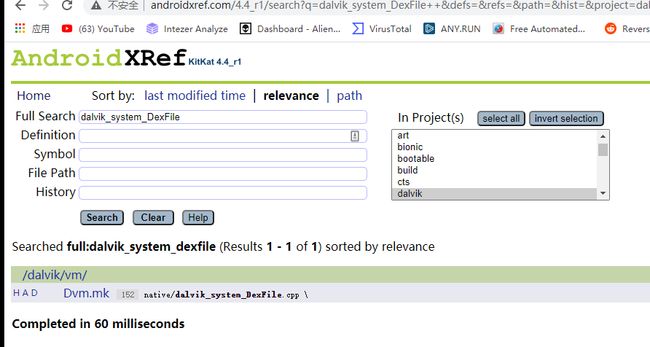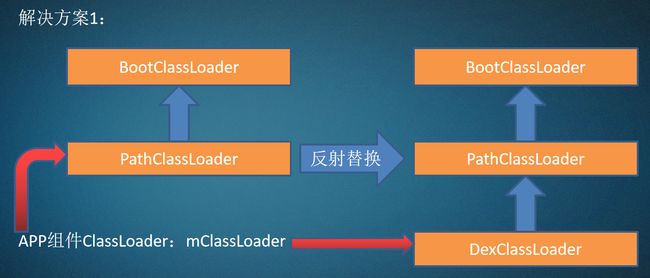安卓加壳与脱壳学习笔记
#grep -Ril "IBM" /tmp
递归列出/tmp目录下包含文本字符串"IBM"的文件
有时要修复dex文件的前八个字节。
ClassLoader和动态加载
类加载器
Android的虚拟机ART和davilk都是JVM的一种实现,使用寄存器来实现。
JVM的类加载器包括3种:
- Bootstrap ClassLoader(引导类加载器)
C/C++代码实现的加载器,用于加载指定的JDK的核心类库,比如java.lang.、java.uti.等这些系统类。Java虚拟机的启动就是通过Bootstrap ,该Classloader在java里无法获取,负责加载/lib下的类。 - Extensions ClassLoader(拓展类加载器)
Java中的实现类为ExtClassLoader,提供了除了系统类之外的额外功能,可以在java里获取,负责加载/lib/ext下的类。 - Application ClassLoader(应用程序类加载器)
Java中的实现类为AppClassLoader,是与我们接触对多的类加载器,开发人员写的代码默认就是由它来加载,ClassLoader.getSystemClassLoader返回的就是它。
双亲委派
双亲委派模式的工作原理的是;如果一个类加载器收到了类加载请求,它并不会自己先去加载,而是把这个请求委托给父类的加载器去执行,如果父类加载器还存在其父类加载器,则进一步向上委托,依次递归,请求最终将到达顶层的启动类加载器,如果父类加载器可以完成类加载任务,就成功返回,倘若父类加载器无法完成此加载任务,子加载器才会尝试自己去加载,这就是双亲委派模式,即每个儿子都不愿意干活,每次有活就丢给父亲去干,直到父亲说这件事我也干不了时,儿子自己想办法去完成,这个就是双亲委派。
为什么要有双亲委派?
- 避免重复加载,如果已经加载过一次Class,可以直接读取已经加载的Class。
- 更加安全,无法自定义类来替代系统的类,可以防止核心API库被随意篡改。
类加载的时机:
隐式加载:
- 创建类的实例
- 访问类的静态变量,或者为静态变量赋值
- 调用类的静态方法
- 使用反射方式来强制创建某个类或接口对应的java.lang.Class对象
- 初始化某个类的子类
显式加载:两者又有所区别
- 使用LoadClass()加载
- 使用forName()加载
- 通过源码分析Android下类加载的流程
类加载
- 装载:查找和导入Class文件
- 链接:其中解析步骤是可以选择的
(a)检查:检查载入的class文件数据的正确性
(b)准备:给类的静态变量分配存储空间
(c)解析:将符号引用转成直接引用 - 初始化:即调用函数,对静态变量,静态代码块执行初始化工作
Android类加载器
ClassLoader的继承关系,其中,InMemoryDexClassLoader为Android8.0新引入的ClassLoader.

Android系统中与ClassLoader相关的一共有8个:
ClassLoader为抽象类;
BootClassLoader预加载常用类,单例模式。与Java中的BootClassLoader不同,它并不是由C/C++代码实现,而是由Java实现的;
BaseDexClassLoader是PathClassLoader、DexClassLoader、InMemoryDexClassLoader的父类,类加载的主要逻辑都是在BaseDexClassLoader完成的。
SecureClassLoader继承了抽象类ClassLoader,拓展了ClassLoader类加入了权限方面的功能,加强了安全性,其子类URLClassLoader是用URL路径从jar文件中加载类和资源。
其中重点关注的是PathClassLoader和DexClassLoader。
PathClassLoader是Android默认使用的类加载器,一个apk中的Activity等类便是在其中加载。
DexClassLoader可以加载任意目录下的dex/jar/apk/zip文件,比PathClassLoader更灵活,是实现插件化、热修复以及dex加壳的重点。
Android8.0新引入InMemoryDexClassLoader,从名字便可看出是用于直接从内存中加载dex。
ClassLoader:
实例
写一个加载SD卡dex的app,原dex的源文件如下:

加载app如下:
首先要添加SD卡权限。
package com.yrq.loaddex;
import androidx.appcompat.app.AppCompatActivity;
import android.content.Context;
import android.os.Bundle;
import java.io.File;
import java.lang.reflect.InvocationTargetException;
import java.lang.reflect.Method;
import dalvik.system.DexClassLoader;
public class MainActivity extends AppCompatActivity {
@Override
protected void onCreate(Bundle savedInstanceState) {
super.onCreate(savedInstanceState);
setContentView(R.layout.activity_main);
Context appContext=this.getApplicationContext();
testDexClassLoader(appContext,"/sdcard/3.dex");
}
//context用于获取APP私有目录
public void testDexClassLoader(Context context,String dexFilePath){
File opfile=context.getDir("opt_dex",0);//存放提出的dex文件
File libfile=context.getDir("Lib_dex",0);//存放依赖的so文件
DexClassLoader dexClassLoader=new DexClassLoader(dexFilePath,opfile.getAbsolutePath(),libfile.getAbsolutePath(),context.getClassLoader());
//package com.yrq.test02;
Class clazz=null;
try {
clazz=(Class)dexClassLoader.loadClass("com.yrq.test02.TestClass");
} catch (ClassNotFoundException e) {
e.printStackTrace();
}
if(clazz!=null){
try {
Method testFun=clazz.getDeclaredMethod("testFun");
try {
Object obj=clazz.newInstance();
try {
testFun.invoke(obj);
} catch (InvocationTargetException e) {
e.printStackTrace();
}
} catch (IllegalAccessException e) {
e.printStackTrace();
} catch (InstantiationException e) {
e.printStackTrace();
}
} catch (NoSuchMethodException e) {
e.printStackTrace();
}
}
}
}
结果
01-15 03:30:47.306 26185-26185/com.yrq.loaddex I/YRQ: i am from com.yrq.test02.TestClass.testFUnc
加壳APP运行流程和ClassLoader修正
App进程的创建流程:

其中这个函数ActivityThread为单例模式。
这个类中有一个静态函数currentActivityThread,可以通过其获取ActivityThread实例。
其中有个ArrayMap的loadedApk变量中就有加载App的mClassloader即pathclassloader。

关于app的执行。直到handlebindapplication函数里的makeApplication,才开始执行App的代码。
private void handleBindApplication(AppBindData data) {
//step 1: 创建LoadedApk对象
data.info = getPackageInfoNoCheck(data.appInfo, data.compatInfo);
...
//step 2: 创建ContextImpl对象;
final ContextImpl appContext = ContextImpl.createAppContext(this, data.info);
//step 3: 创建Instrumentation
mInstrumentation = new Instrumentation();
//step 4: 创建Application对象;在makeApplication函数中调用了newApplication,在该函数中又调用了app.attach(context),在attach函数中调用了Application.attachBaseContext函数
Application app = data.info.makeApplication(data.restrictedBackupMode, null);
mInitialApplication = app;
//step 5: 安装providers
List providers = data.providers;
installContentProviders(app, providers);
//step 6: 执行Application.Create回调
mInstrumentation.callApplicationOnCreate(app);
APP运行流程
- BootClassLoader加载系统核心库
- PathClassLoader加载APP自身dex
- 进入APP自身组件开始执行
- 调用声明Application的attachBaseContext
- 调用声明Application的onCreate
加壳应用的运行流程

在加壳程序中,不能直接跟加载插件一样使用DexClassLoader,因为系统的PathClassLoader要加载一些组件,这些组件都无法找到。就引出了一个问题:怎么解决动态加载dex中类的声明周期,怎么加载插件dex中的activity。
生命周期类处理
DexClassLoader加载的类是没有组件生命周期的,也就是说即使DexClassLoader通过对APK的动态加载完成了对组件类的加载,当系统启动该组件时,依然会出现加载类失败的异常。为什么组件类被动态加载入虚拟机,但系统却出现加载类失败呢?
两种解决方案:
1、替换系统组件类加载器为我们的DexClassLoader,同时设置DexClassLoader的parent为系统组件类加载器;
2、打破原有的双亲关系,在系统组件类加载器和BootClassLoader的中间插入我们自己的DexClassLoader即可;
package com.yrq.loaddex;
import androidx.appcompat.app.AppCompatActivity;
import android.app.Activity;
import android.content.Context;
import android.content.Intent;
import android.os.Bundle;
import android.util.ArrayMap;
import java.io.File;
import java.lang.ref.WeakReference;
import java.lang.reflect.Field;
import java.lang.reflect.InvocationTargetException;
import java.lang.reflect.Method;
import dalvik.system.DexClassLoader;
public class MainActivity extends AppCompatActivity {
@Override
protected void onCreate(Bundle savedInstanceState) {
super.onCreate(savedInstanceState);
setContentView(R.layout.activity_main);
Context appContext=this.getApplicationContext();
//testDexClassLoader(appContext,"/sdcard/3.dex");
startTestActivity(this,"/sdcard/4.dex");
}
//第一种解决方案,自己实现的DexClassLoader替换APP组件ClassLoader:mClassLoader
第一步是找到mclassloader
public void replaceClassloader(ClassLoader classloader){
//首先获得ActivityThread实例
try {
Class ActivityThreadClazz=classloader.loadClass("android.app.ActivityThread");
Method CurrentActivityThreadMethod=ActivityThreadClazz.getDeclaredMethod("currentActivityThread");
CurrentActivityThreadMethod.setAccessible(true);
Object activityThreadObj=CurrentActivityThreadMethod.invoke(null);
//final ArrayMap> mPackages = new ArrayMap<>();获取arrayMap
//Class是对类的抽象,Field是对类的属性的抽象,可以通过Class获取到Field
Field mPackageField=ActivityThreadClazz.getDeclaredField("mPackages");
mPackageField.setAccessible(true);
ArrayMap mPackagesObj= (ArrayMap) mPackageField.get(activityThreadObj);
第一个参数是String类型,就是我们当前的包名
WeakReference wr= (WeakReference) mPackagesObj.get(this.getPackageName());
Object loadedApkObj=wr.get();
//从loadedApk中取出mClassLoader
Class LoaderApkClazz=classloader.loadClass("android.app.LoadedApk");
Field mClassLoader=LoaderApkClazz.getDeclaredField("mClassLoader");
mClassLoader.setAccessible(true);
mClassLoader.set(loadedApkObj,classloader);
} catch (ClassNotFoundException e) {
e.printStackTrace();
} catch (NoSuchMethodException e) {
e.printStackTrace();
} catch (IllegalAccessException e) {
e.printStackTrace();
} catch (InvocationTargetException e) {
e.printStackTrace();
} catch (NoSuchFieldException e) {
e.printStackTrace();
}
}
//编写函数,加载插件中dex的activity
public void startTestActivity(Context context,String dexFilePath){
File opfile=context.getDir("opt_dex",0);//存放提出出的dex文件
File libfile=context.getDir("Lib_dex",0);//存放依赖的so文件
DexClassLoader dexClassLoader=new DexClassLoader(dexFilePath,opfile.getAbsolutePath(),libfile.getAbsolutePath(),context.getClassLoader());
replaceClassloader(dexClassLoader);
//package com.yrq.test02;
Class clazz=null;
try {
clazz=(Class)dexClassLoader.loadClass("com.yrq.test02.TestActivity");
} catch (ClassNotFoundException e) {
e.printStackTrace();
}
context.startActivity(new Intent(context,clazz));
}
}
结果如下:
01-15 19:17:32.768 29796-29796/com.yrq.loaddex I/YRQ: i am from TestActivity.onCreate
package com.yrq.loaddex;
import androidx.appcompat.app.AppCompatActivity;
import android.app.Activity;
import android.content.Context;
import android.content.Intent;
import android.os.Bundle;
import android.util.ArrayMap;
import android.util.Log;
import java.io.File;
import java.lang.ref.WeakReference;
import java.lang.reflect.Field;
import java.lang.reflect.InvocationTargetException;
import java.lang.reflect.Method;
import dalvik.system.DexClassLoader;
public class MainActivity extends Activity {
@Override
protected void onCreate(Bundle savedInstanceState) {
super.onCreate(savedInstanceState);
setContentView(R.layout.activity_main);
Context appContext=this.getApplicationContext();
//testDexClassLoader(appContext,"/sdcard/3.dex");
//startTestActivityFirstMethod(this,"/sdcard/4.dex");
startTestActivitySecondMethod(this,"/sdcard/6.dex");
}
//context用于获取APP私有目录
public void startTestActivitySecondMethod(Context context,String dexFilePath){
File opfile=context.getDir("opt_dex",0);//存放提出出的dex文件
File libfile=context.getDir("lib_dex",0);//存放依赖的so文件
ClassLoader pathClassloader=MainActivity.class.getClassLoader();
ClassLoader bootClassLoader=MainActivity.class.getClassLoader().getParent();
//父节点设置成bootClassloader
//1:dexPath,指目标类所在的APK或jar文件的路径.类装载器将从该路径中寻找指定的目标类,该类必须是APK或jar的全路径.如果要包含多个路径,路径之间必须使用特定的分割符分隔,特定的分割符可以使用System.getProperty(“path.separtor”)获得.
//2:dexOutputDir,由于dex文件被包含在APK或者Jar文件中,因此在装载目标类之前需要先从APK或Jar文件中解压出dex文件,该参数就是制定解压出的dex 文件存放的路径.在Android系统中,一个应用程序一般对应一个Linux用户id,应用程序仅对属于自己的数据目录路径有写的权限,因此,该参数可以使用该程序的数据路径.
//3:libPath,指目标类中所使用的C/C++库存放的路径
//4:最后一个参数是指该装载器的父装载器,一般为当前执行类的装载器
DexClassLoader dexClassLoader=new DexClassLoader(dexFilePath,opfile.getAbsolutePath(),libfile.getAbsolutePath(),bootClassLoader);
//dexClassLoader子节点设置成app的PathClassloader
try {
Field parentField=ClassLoader.class.getDeclaredField("parent");
parentField.setAccessible(true);
parentField.set(pathClassloader,dexClassLoader);
} catch (NoSuchFieldException e) {
e.printStackTrace();
} catch (IllegalAccessException e) {
e.printStackTrace();
}
ClassLoader tmpClassloader=pathClassloader;
ClassLoader parentClassloader=pathClassloader.getParent();
while(parentClassloader!=null){
Log.i("YRQ","this:"+tmpClassloader+"--parent:"+parentClassloader);
tmpClassloader=parentClassloader;
parentClassloader=parentClassloader.getParent();
}
Log.i("YRQ","root:"+tmpClassloader);
//package com.yrq.test02;
Class clazz=null;
try {
clazz=(Class)dexClassLoader.loadClass("com.yrq.test02.TestActivity");
} catch (ClassNotFoundException e) {
e.printStackTrace();
}
context.startActivity(new Intent(context,clazz));
}
}
一二三代壳和加壳技术分类识别
| 壳类型 | 介绍 |
|---|---|
| 第一代 | Dex字符串加密资源加密对抗反编译反调试自定义DexClassLoader,整体保护dex |
| 第二代 | 对抗第一代常见的脱壳办法Dex Method代码抽取到外部,Dex动态加载So加密 |
| 第三代 | Dex Method代码解密So代码膨胀混淆对抗之前的所有脱壳法 |
| 第四代 | VMP |
Dalvik下一代壳通用解决方案
因为Dalvik是4.4之前的版本,所有我们可以查看DexClassLoader 4.4的版本。

public DexClassLoader(String dexPath, //dex的路径
String optimizedDirectory,//odex存放路径
String libraryPath, //涉及的so路径
ClassLoader parent //双亲父节点
) {
super(dexPath, new File(optimizedDirectory), libraryPath, parent);
}
可以看到父类是BaseDexClassLoader
public class BaseDexClassLoader extends ClassLoader {
private final DexPathList pathList;
可以看到是BaseDexClassLoader父类ClassLoader
可以看到4.4有art和davlik,我们要查看的是davlik

可以看到只是设置父节点
ClassLoader(ClassLoader parentLoader, boolean nullAllowed) {
if (parentLoader == null && !nullAllowed) {
throw new NullPointerException("parentLoader == null && !nullAllowed");
}
parent = parentLoader;
}
所以回到BaseDexClassLoader
可以看到初始化DexPathList实例
public class BaseDexClassLoader extends ClassLoader {
private final DexPathList pathList;
/**
* Constructs an instance.
*
* @param dexPath the list of jar/apk files containing classes and
* resources, delimited by {@code File.pathSeparator}, which
* defaults to {@code ":"} on Android
* @param optimizedDirectory directory where optimized dex files
* should be written; may be {@code null}
* @param libraryPath the list of directories containing native
* libraries, delimited by {@code File.pathSeparator}; may be
* {@code null}
* @param parent the parent class loader
*/
public BaseDexClassLoader(String dexPath, File optimizedDirectory,
String libraryPath, ClassLoader parent) {
super(parent);
this.pathList = new DexPathList(this, dexPath, libraryPath, optimizedDirectory);
}
可以看到第二个参数是我们关心的dexPath,要加载的dex文件
public DexPathList(ClassLoader definingContext, String dexPath,
String libraryPath, File optimizedDirectory) {
if (definingContext == null) {
throw new NullPointerException("definingContext == null");
}
if (dexPath == null) {
throw new NullPointerException("dexPath == null");
}
if (optimizedDirectory != null) {
if (!optimizedDirectory.exists()) {
throw new IllegalArgumentException(
"optimizedDirectory doesn't exist: "
+ optimizedDirectory);
}
if (!(optimizedDirectory.canRead()
&& optimizedDirectory.canWrite())) {
throw new IllegalArgumentException(
"optimizedDirectory not readable/writable: "
+ optimizedDirectory);
}
}
this.definingContext = definingContext;
ArrayList suppressedExceptions = new ArrayList();
this.dexElements = makeDexElements(splitDexPath(dexPath), optimizedDirectory,
suppressedExceptions);
if (suppressedExceptions.size() > 0) {
this.dexElementsSuppressedExceptions =
suppressedExceptions.toArray(new IOException[suppressedExceptions.size()]);
} else {
dexElementsSuppressedExceptions = null;
}
this.nativeLibraryDirectories = splitLibraryPath(libraryPath);
}
重要函数为makeDexElements,进入此函数查看
private static Element[] makeDexElements(ArrayList files, File optimizedDirectory,
ArrayList suppressedExceptions) {
ArrayList elements = new ArrayList();
返回了一个Element[]数组,这个在DexPathList也有定义
/**
* Element of the dex/resource file path
*/
/*package*/ static class Element {
private final File file;
private final boolean isDirectory;
private final File zip;
private final DexFile dexFile;
private ZipFile zipFile;
private boolean initialized;
public Element(File file, boolean isDirectory, File zip, DexFile dexFile) {
this.file = file;
this.isDirectory = isDirectory;
this.zip = zip;
this.dexFile = dexFile;
}
可以看到就是loadDexFile,然后添加进Element[]数组
private static Element[] makeDexElements(ArrayList files, File optimizedDirectory,
ArrayList suppressedExceptions) {
ArrayList elements = new ArrayList();
/*
* Open all files and load the (direct or contained) dex files
* up front.
*/
for (File file : files) {
File zip = null;
DexFile dex = null;
String name = file.getName();
if (name.endsWith(DEX_SUFFIX)) {
// Raw dex file (not inside a zip/jar).
try {
dex = loadDexFile(file, optimizedDirectory);
} catch (IOException ex) {
System.logE("Unable to load dex file: " + file, ex);
}
} else if (name.endsWith(APK_SUFFIX) || name.endsWith(JAR_SUFFIX)
|| name.endsWith(ZIP_SUFFIX)) {
zip = file;
try {
dex = loadDexFile(file, optimizedDirectory);
} catch (IOException suppressed) {
/*
* IOException might get thrown "legitimately" by the DexFile constructor if the
* zip file turns out to be resource-only (that is, no classes.dex file in it).
* Let dex == null and hang on to the exception to add to the tea-leaves for
* when findClass returns null.
*/
suppressedExceptions.add(suppressed);
}
} else if (file.isDirectory()) {
// We support directories for looking up resources.
// This is only useful for running libcore tests.
elements.add(new Element(file, true, null, null));
} else {
System.logW("Unknown file type for: " + file);
}
if ((zip != null) || (dex != null)) {
elements.add(new Element(file, false, zip, dex));
}
}
return elements.toArray(new Element[elements.size()]);
查看loadDexFile,第一个参数是dex文件,可以看到再次调用loadDex
private static DexFile loadDexFile(File file, File optimizedDirectory)
throws IOException {
if (optimizedDirectory == null) {
return new DexFile(file);
} else {
String optimizedPath = optimizedPathFor(file, optimizedDirectory);
return DexFile.loadDex(file.getPath(), optimizedPath, 0);
}
}
可以看到loadDex第一个参数是dex路径,返回是新建DexFile对象
static public DexFile loadDex(String sourcePathName, String outputPathName,
int flags) throws IOException {
/*
* TODO: we may want to cache previously-opened DexFile objects.
* The cache would be synchronized with close(). This would help
* us avoid mapping the same DEX more than once when an app
* decided to open it multiple times. In practice this may not
* be a real issue.
*/
return new DexFile(sourcePathName, outputPathName, flags);
}
DexFile对象中,调用了openDexFile,返回mCookie
private DexFile(String sourceName, String outputName, int flags) throws IOException {
if (outputName != null) {
try {
String parent = new File(outputName).getParent();
if (Libcore.os.getuid() != Libcore.os.stat(parent).st_uid) {
throw new IllegalArgumentException("Optimized data directory " + parent
+ " is not owned by the current user. Shared storage cannot protect"
+ " your application from code injection attacks.");
}
} catch (ErrnoException ignored) {
// assume we'll fail with a more contextual error later
}
}
mCookie = openDexFile(sourceName, outputName, flags);
mFileName = sourceName;
guard.open("close");
//System.out.println("DEX FILE cookie is " + mCookie);
}
可以看到此函数又调用了openDexFileNative。
private static int openDexFile(String sourceName, String outputName,
int flags) throws IOException {
return openDexFileNative(new File(sourceName).getCanonicalPath(),
(outputName == null) ? null : new File(outputName).getCanonicalPath(),
flags);
}
在android中每个JNI实现有规律就是类名/改成_
dalvik/system/DexFile变成dalvik_system_DexFile


如下就是native层次函数代码
static void Dalvik_dalvik_system_DexFile_openDexFileNative(const u4* args,
JValue* pResult)
{
StringObject* sourceNameObj = (StringObject*) args[0];
StringObject* outputNameObj = (StringObject*) args[1];
DexOrJar* pDexOrJar = NULL;
JarFile* pJarFile;
RawDexFile* pRawDexFile;
char* sourceName;
char* outputName;
if (sourceNameObj == NULL) {
dvmThrowNullPointerException("sourceName == null");
RETURN_VOID();
}
。。。。
//后缀校验
if (hasDexExtension(sourceName)
&& dvmRawDexFileOpen(sourceName, outputName, &pRawDexFile, false) == 0) {
ALOGV("Opening DEX file '%s' (DEX)", sourceName);
之后就是各种读文件,优化OPT
通用脱壳点
编译源码,对dexFileParse、dvmDexFileOpenPartial脱壳点的验证。第一个参数是地址,第二个参数一般是长度。
分别添加如下代码


添加头文件
#include
#include
#include
下面就是编译 -j就是多线程
source build/envsetup.sh
tom@ubuntu:~/SourceCode/android-4.4.4_r1$ lunch
You're building on Linux
Lunch menu... pick a combo:
1. aosp_arm-eng
2. aosp_x86-eng
3. aosp_mips-eng
4. vbox_x86-eng
5. aosp_manta-userdebug
6. aosp_mako-userdebug
7. aosp_hammerhead-userdebug
8. aosp_flo-userdebug
9. aosp_tilapia-userdebug
10. aosp_grouper-userdebug
11. aosp_deb-userdebug
12. mini_x86-userdebug
13. mini_armv7a_neon-userdebug
14. mini_mips-userdebug
Which would you like? [aosp_arm-eng] 7
============================================
PLATFORM_VERSION_CODENAME=REL
PLATFORM_VERSION=4.4.4
TARGET_PRODUCT=aosp_hammerhead
TARGET_BUILD_VARIANT=userdebug
TARGET_BUILD_TYPE=release
TARGET_BUILD_APPS=
TARGET_ARCH=arm
TARGET_ARCH_VARIANT=armv7-a-neon
TARGET_CPU_VARIANT=krait
HOST_ARCH=x86
HOST_OS=linux
HOST_OS_EXTRA=Linux-4.15.0-88-generic-x86_64-with-Ubuntu-16.04-xenial
HOST_BUILD_TYPE=release
BUILD_ID=KTU84P
OUT_DIR=out
============================================
tom@ubuntu:~/SourceCode/android-4.4.4_r1$ time make -j4
============================================
编译完成
+ OUTPUT_FILE=out/target/product/hammerhead/obj/PACKAGING/systemimage_intermediates/system.img
+ EXT_VARIANT=ext4
+ MOUNT_POINT=system
+ SIZE=1073741824
+ FC=out/target/product/hammerhead/root/file_contexts
+ case $EXT_VARIANT in
+ '[' -z system ']'
+ '[' -z 1073741824 ']'
+ '[' -n out/target/product/hammerhead/root/file_contexts ']'
+ FCOPT='-S out/target/product/hammerhead/root/file_contexts'
+ MAKE_EXT4FS_CMD='make_ext4fs -s -S out/target/product/hammerhead/root/file_contexts -l 1073741824 -a system out/target/product/hammerhead/obj/PACKAGING/systemimage_intermediates/system.img out/target/product/hammerhead/system'
+ echo make_ext4fs -s -S out/target/product/hammerhead/root/file_contexts -l 1073741824 -a system out/target/product/hammerhead/obj/PACKAGING/systemimage_intermediates/system.img out/target/product/hammerhead/system
make_ext4fs -s -S out/target/product/hammerhead/root/file_contexts -l 1073741824 -a system out/target/product/hammerhead/obj/PACKAGING/systemimage_intermediates/system.img out/target/product/hammerhead/system
+ make_ext4fs -s -S out/target/product/hammerhead/root/file_contexts -l 1073741824 -a system out/target/product/hammerhead/obj/PACKAGING/systemimage_intermediates/system.img out/target/product/hammerhead/system
Creating filesystem with parameters:
Size: 1073741824
Block size: 4096
Blocks per group: 32768
Inodes per group: 8192
Inode size: 256
Journal blocks: 4096
Label:
Blocks: 262144
Block groups: 8
Reserved block group size: 63
Created filesystem with 1429/65536 inodes and 76583/262144 blocks
+ '[' 0 -ne 0 ']'
Install system fs image: out/target/product/hammerhead/system.img
out/target/product/hammerhead/system.img+out/target/product/hammerhead/obj/PACKAGING/recovery_patch_intermediates/recovery_from_boot.p maxsize=1096212480 blocksize=135168 total=298434830 reserve=11083776
real 2m9.789s
user 1m50.879s
sys 0m16.426s
将编译好的文件拷出

然后就可以脱壳操作了。加载apk时,会再如代码缩写,sdcard生成dex
ART下一代壳通用解决方案
8.0之后引入InMemoryClassLoader。
可以看到InMemoryClassLoader调用了BaseDexClassloader。
又调用了DexPathlist,调用makeInMemoryDexElements
然后遍历dexFiles对象,创建element的数组保存DexFile。
DexFile中openInMemoryDexFile被调用。
这个函数中create函数,调用了CreateSingleDexfileCookie
此函数里创建了dex_file
里面CreateDexFiles
这些很多函数都涉及了起始地址与长度,所以可以在这些点脱壳。
这些函数有
1.static jobject CreateSingleDexFileCookie(JNIEnv* env, std::unique_ptr data)
2、static const DexFile* CreateDexFile(JNIEnv* env, std::unique_ptr dex_mem_map)
3、DexFile::Open(location,
4、OpenCommon(map->Begin()
5、DexFile::DexFile(const uint8_t* base,
art下函数抽取的方案思路就是阻断dex2oat流程。
阻断之后,就会进入加载dex文件流程,可以在以下函数点进行脱壳(就是有dex路径作为参数的函数)
1、OpenAndReadMagic(filename, &magic, error_msg); 2、DexFile::OpenCommon(const uint8_t* base, 3、DexFile::DexFile(const uint8_t* base,
FART
脱壳组件
apk安装时进行的dex2oat编译流程

DexClassLoader再最后回调用dex2oat进行编译,dex2oat是一个二进制文件,在dex2oat中按函数粒度编译,不编译类的初始化函数,类的初始化函数运行在解释interpreter模式下,所以如果禁用dex2oat,所有函数都运行在解释模式下。

关于解释器实现可以看到2种,switch和汇编

我们在脱壳时,比如初始化函数也对应着可以通过ArtMethod对象,ArtMethod对象提供了一个函数GetDexFile(),用来获取所属的DexFile。DexFile中提供了Begin()和Size()函数,获取dexfile的开始和大小,就可以得到dex文件进行dump。
FART的脱壳点是在解释器下的Execute()。 路径为art中runtime目录
//首先获取当前执行Artmethod
ArtMethod* artmethod=shadow_frame.GetMethod();
//防止多次dump引起卡顿,只在初始化函数dump
if(strstr(artmethod->PrettyMethod().c_str(),""))
{
//inline const DexFile* ArtMethod::GetDexFile()
const DexFile* dexfile=artmethod->GetDexFile();
/* const uint8_t* Begin() const {
1050 return begin_;
1051 }
1052
1053 size_t Size() const {
1054 return size_;
1055 }*/
const uint8_t* begin=dexfile->Begin();
size_t size=dexfile->Size();
//拼接存储路径
char dexfilepath[100]={0};
sprintf(dexfilepath,"/sdcard/%d_%d_Execute.dex",(int)size,getpid());
int fd=open(dexfilepath,O_CREAT|O_RDWR,0666);
if(fd>0)
{
int number=write(fd,begin,size);
if(number>0){
}
close(fd);
}
}
记得如下头文件
#include
#include
#include
主动调用组件
相关概念

关于dex,如果没有异常处理,长度即头部长度加指令长度,有异常处理还要加异常处理部分。

FART脱壳结束得到的文件列表。

手动修复教程
首先安装fart镜像,安装运行APK,将Sdcard卡目录下dump文件夹保存脱下来

打开GDA观察,函数都被抽空。

然后就用dump下了的codeItem进行修复
使用脚本fart.py脚本,格式为
-d xxx.dex -i xxx.bin >> result
结果如下:

参考资料
看雪视频



